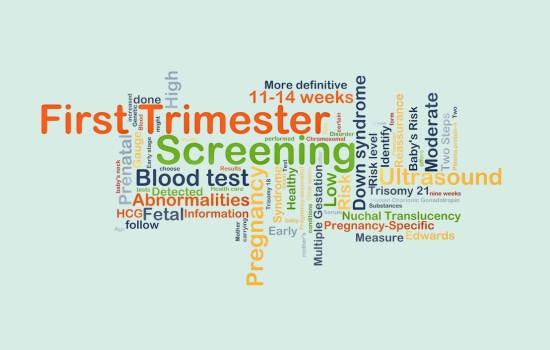The first trimester screening test is a prenatal genetic test that helps doctors identify chromosomal abnormalities in the fetus. It’s offered to ALL pregnant women, but doctors particularly encourage women of “advanced maternal age” (women who are 35 years & older at the time of delivery) and those with a family history of chromosomal abnormalities to get it.
When is the First Trimester Screen Done?
Between 11-13 weeks of pregnancy.
What’s Included in the First Trimester Screen?
A blood test and an ultrasound.
- The blood test looks at two specific hormone levels: PAPP-A (pregnancy-associated plasma protein A) and your old friend hCG (human chorionic gonadotropin) – the hormone that turns home pregnancy tests positive.
- The ultrasound measures the fluid-filled space at the back of the fetus’s neck (fancy term: the nuchal fold). All fetuses have this fluid-filled space, but a thicker-than-normal nuchal fold is a soft marker for Down Syndrome.
What Does the First Trimester Screen Tell Me?
Your odds of having a baby with Down Syndrome (Trisomy 21) or Edwards Syndrome (Trisomy 18).
- Down Syndrome is a condition characterized by intellectual disability (a low IQ) and certain physical features (such as short stature, small ears, almond-shaped eyes that slant upwards, and a protruding tongue). The most common cause of Down Syndrome is an extra copy of chromosome 21. Patients with Down Syndrome have 3 copies of chromosome 21 in their cells (vs. the usual 2 copies).
- Edwards Syndrome is caused by an extra chromosome 18. In this case, patients have 3 copies of chromosome 18 in their cells. This leads to a host of problems, including severe intellectual disability, heart problems, a low birth weight, a small, abnormally-shaped head, deformed feet, and clenched fists with overlapping fingers. Sadly, only 5-10% of babies with Edwards Syndrome live past their first year of life.1
Reality Check: Though serious, Edwards Syndrome, is extremely rare.
Getting The Results
The results of the first trimester screen are usually available within 7-10 days.
- Your doctor will call you to discuss the findings, so you don’t have to decipher them yourself.
- For your knowledge, the results come back as a “risk assessment.” For example, if your baby is found to have a 1 in 5,000 risk of having Down Syndrome, they would be considered “low risk” for the disease. A “high risk” result typically refers to a risk of 1 in 200 (or greater). Exactly how the risk level is interpreted depends on the disease and on the lab that conducted the test, so let your doctor worry about the details.
Is the First Trimester Screen a Perfect Test?
As we all know (but don’t always accept), nothing is perfect in life, including the first trimester screen.
For Those of You Who Like Numbers:
The First Trimester Screen Correctly Identifies:
- ~85% of women carrying a baby with Down Syndrome (with a 5% false positive rate – i.e. the test is positive even though Mom-to-be isn’t carrying a baby with Down Syndrome).2
- ~90% of women carrying a baby with Edwards Syndrome (with a false positive rate of 2%).3
The Bottom Line
The first trimester screen is pretty good at ruling out Down Syndrome and Edward Syndrome. This means that a negative result is reassuring and a positive test isn’t necessarily cause for panic. If your First Trimester Screen is positive, then a confirmatory test (chorionic villus sampling or a genetic amniocentesis) will be recommended.
Insider Info: The first trimester screen isn’t the only prenatal screening test in town. Get Wise about the NIPS (Non-Invasive Screening) test and the Second Trimester Screening Test, as well.








